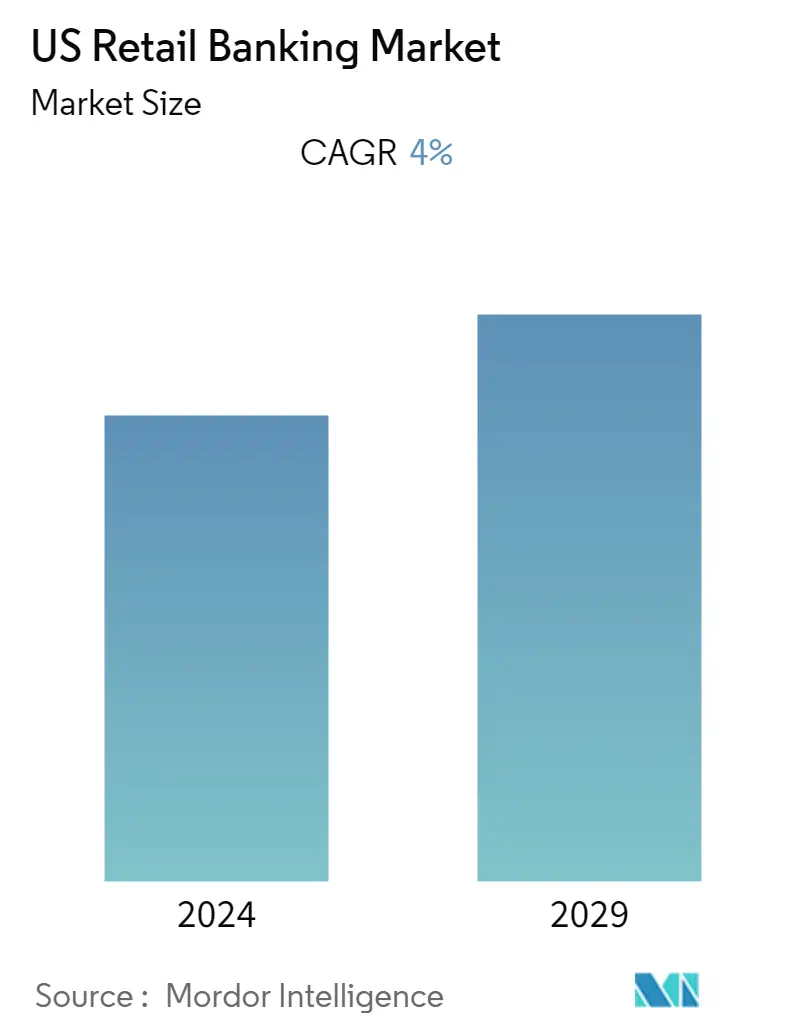Market Size of US Retail Banking Industry

| Study Period | 2020 - 2029 |
| Base Year For Estimation | 2023 |
| Forecast Data Period | 2024 - 2029 |
| Historical Data Period | 2020 - 2022 |
| CAGR | 4.00 % |
| Market Concentration | High |
Major Players
*Disclaimer: Major Players sorted in no particular order |
US Retail Banking Market Analysis
The US retail banking market is expected to witness a CAGR of 4.49%, during the forecast period (2021-2026). The high level of household debt in the country is a direct outcome of a rise in domestic consumption, which has proved to be the driving force of the country's economic growth. The credit card balances outstanding was the fastest-growing credit segment. The rising disposable income in the United States contributes positively toward borrowers' enhanced confidence in repaying their loans.
Fee income is falling, driven by decreased retail spending, while non-performing loan ratios will increase - particularly for SMEs. In March 2020, the US government decided to waive all federal student loan interest to address this issue and protect both consumers' and lenders' interests until further notice. Government support, particularly low-cost funding, will help but ultimately can only mitigate the impact. For banks, the severity of losses will depend on whether lockdown restrictions on individuals and businesses can be lifted without a resurgence in cases, or whether businesses will be forced to declare bankruptcy and borrowers will default on their loans.
Most US retail banking brands have a lot to worry about on the digital front, with new tech competitors on the horizon, digital-first banks eating away at their margins, and continuously rising customer expectations. It is no longer good enough to deliver just basics, like online enrollment. Banks must take the next step in digital innovation to compete with fintechs and online banks.
US Retail Banking Industry Segmentation
Retail banking, also known as consumer banking or personal banking, is banking that provides financial services to individual consumers rather than businesses. Retail banking is a way for individual consumers to manage their money, have access to credit, and deposit their money in a secure manner. Services offered by retail banks include checking and savings accounts, mortgages, personal loans, credit cards, and certificate of deposit (CDs).The report offers a complete background analysis of the US retail banking market, including an assessment of the parental market, emerging trends by segments and regional markets, significant changes in market dynamics, and market overview.
| By Product | |
| Transactional Accounts | |
| Savings Accounts | |
| Debit Cards | |
| Credit Cards | |
| Loans | |
| Other Products |
| By Channel | |
| Direct Sales | |
| Distributor |
US Retail Banking Market Size Summary
The US retail banking market is experiencing a transformative phase driven by digital innovation and changing consumer expectations. As traditional banks face competition from digital-first banks and fintechs, they are compelled to enhance their digital offerings beyond basic online services. This shift is crucial as fintechs have rapidly captured market share by improving customer experiences through features like pre-approvals and faster loan funding. Major US banks are increasingly investing in strategic partnerships with fintechs to leverage their technology and expand their service offerings. This trend is part of a broader movement towards integrating specialized fintech APIs to enhance core banking products and explore new business models.
Despite the challenges posed by rising digital competitors, the US retail banking sector is poised for growth, supported by evolving payment technologies and the potential of open banking. Real-time payments and other advanced payment solutions are becoming essential for engaging commercial customers, improving liquidity management, and reducing fraud. While open banking in the US is driven by industry initiatives rather than regulatory mandates, it offers significant opportunities for banks to accelerate digital transformation and enhance customer experiences. However, consumer concerns about privacy and data security highlight the need for banks to educate their customers about the benefits of these innovations. As the market evolves, major players like Wells Fargo, JP Morgan Chase, and Bank of America continue to dominate, but mid-size and smaller companies are gaining ground through technological advancements and market expansion.
US Retail Banking Market Size - Table of Contents
-
1. MARKET DYNAMICS
-
1.1 Market Overview
-
1.2 Trends Shaping the US Retail Banking Market
-
1.3 Consumer Behavior and Loyalty Analysis
-
1.4 Government Regulations And Industry Policies
-
1.5 Fintech Disruption in the US Retail Banking Market
-
1.6 Affect of Retail Banking on the US Economy
-
1.7 Recent Developments in the Market
-
1.8 The Future of US Retail Banking Distribution
-
1.9 Market Drivers
-
1.9.1 Next generation technologies
-
1.9.2 Optimized physical distribution: Analytics and workforce fluidity
-
1.9.3 Developing an omnichannel workforce
-
-
1.10 Market Restraints
-
1.10.1 Big Tech is a growing disintermediation threat
-
-
1.11 Porters 5 Force Analysis
-
1.11.1 Threat of New Entrants
-
1.11.2 Bargaining Power of Buyers/Consumers
-
1.11.3 Bargaining Power of Suppliers
-
1.11.4 Threat of Substitute Products
-
1.11.5 Intensity of Competitive Rivalry
-
-
1.12 Impact of Covid 19 on the Market
-
-
2. MARKET SEGMENTATION
-
2.1 By Product
-
2.1.1 Transactional Accounts
-
2.1.2 Savings Accounts
-
2.1.3 Debit Cards
-
2.1.4 Credit Cards
-
2.1.5 Loans
-
2.1.6 Other Products
-
-
2.2 By Channel
-
2.2.1 Direct Sales
-
2.2.2 Distributor
-
-
US Retail Banking Market Size FAQs
What is the current US Retail Banking Market size?
The US Retail Banking Market is projected to register a CAGR of 4% during the forecast period (2024-2029)
Who are the key players in US Retail Banking Market?
PNC Financial Services, Bank of America, US Bank, JP Morgan Chase and Co. and Wells Fargo are the major companies operating in the US Retail Banking Market.

